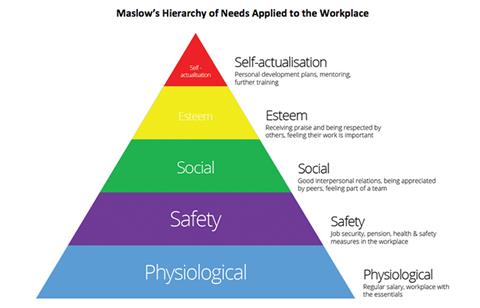What motivates your employees? What keeps them engaged with your company and stops them looking elsewhere for new opportunities?Whilst many might think that providing a regular salary and a comfortable work environment is all that is needed by an employer, we’re going to look at the psychology of motivation and break down the key factors that influence human behaviour so that you, as employers, can ensure you’re getting the most from your employees.
Back in the 1940s, psychologist Abraham Maslow published his Theory of Human Motivation. Fundamentally, Maslow believed that all human beings have the innate desire to be all that they can be (referred to as self-actualisation). This is great news for employers as inspired and hard-working individuals constantly striving to achieve their best are a dream for any company.
However, in order to unlock this desire within people, Maslow believed that more basic needs have to be met first of all. According to Maslow, humans work their way up through a hierarchy (see image below) in terms of needs that they are looking to fulfilled, starting with the most basic physiological needs. Our needs are constantly changing so as soon as a certain tier’s needs have been fulfilled, we begin to desire the next tier’s needs to be met. However, all the time that the needs from a lower tier on this hierarchy remain unfulfilled, a person will not be influenced by the levels further up.

How can you apply this to your place of work?According to Maslow¹, only 2% of people achieve self-actualisation in this hierarchy. In order to help more of your employees reach this level of motivation, where they’re actively looking for opportunities to develop and improve, it is important to ensure you are doing all you can to meet their other needs: physiological, safety, social and esteem.
The bottom two levels of physiological and safety needs are fairly straight-forward for most organisations to meet – these needs can be met by providing employment contracts, a safe and comfortable work environment, a regular salary and any other benefits that may help employees feel secure such as a workplace pension and sick pay. On their own, these don’t engage employees with you as a company and they’re unlikely to feel any emotional loyalty to you as an employer but they are important as the fundamental building blocks of a satisfying professional life and career.
It is the social and esteem needs which can be a bit trickier for employers to crack as they go above and beyond the basic requirements and require certain values to be instilled into the company culture from the top-down. In terms of social needs, people want a sense of belonging and desire good interpersonal relations with their peers. Many organisations arrange team-building activities throughout the year to build relationships within their teams but another way of building on this is by encouraging employee-to-employee recognition within your company. Whether it is a “thanks” given in person or a digital ecard saying “well done” sent to the employee, these team recognition activities have been shown² to have positive effects on both those who give recognition and those who receive it.
Once a person has this sense of belonging, they will move on to see how their esteem needs are being met. At this stage, employees are looking to see that their work is valued by their employer. Again, employee appreciation plays a big role at this stage as recognising and rewarding an employee’s achievements helps them form a positive self-image of themselves. If an employee is given a tangible reward, particularly one that they can choose themselves, they will emotionally connect this reward with their job and feel important and accomplished as a result.
The positive impact of meeting your employees’ needsBy meeting your employees’ needs at these levels, you encourage positive engagement with your organisation and increase the confidence that employees have in their work. As a result, it can have a remarkable impact on employee retention as they feel little need to look elsewhere for their needs to be fulfilled. However, it is important to note that meeting these needs is not just a one-time occurrence that will satisfy them for life. It is something that needs to be repeated and instilled as part of the company culture – awarding someone a corporate employee award for an achievement two years ago is not going to keep them feeling valued today.
Although it can be difficult to meet all your employees’ needs all the time, once you do have an employee who feel that their basic needs have been met, that they’re a key member of the team and that their work is appreciated by their employer, they will feel inspired to take on more ownership and responsibility within their role and this can even have a positive knock-on effect to the rest of your employees who are likely to feel inspired by this employee’s attitude to work.
About Each PersonTo find out more about the Each Person employee recognition and reward scheme, visit www.eachperson.com
References:
¹ Maslow, A. (1970), Motivation and Personality, (2nd ed.). New York: Harper & Row
² Higginbottom, K. (2016), "It's Better To Give Than To Receive At Work", Forbes (http://bit.ly/2pdKUdQ)











